Reverse osmosis systems offer one of the best ways of producing clean water for your household. Unlike other water filtering solutions, these systems are very efficient, being capable of removing up to 95 – 99% of the contaminants floating in your water.
In the following article, we take a closer look at the top-rated 11 RO systems you can buy, and we reveal their pros and cons.
Are you new to reverse osmosis water filters? You came to the right place. Our comprehensive buying guide and reviews will provide all the information you need to make an informed decision about the best reverse osmosis system for your household. We explain how an RO system works, and what each specific term means, so you can understand all the product descriptions you read.
Reverse osmosis filters have easy installation and low maintenance, and it shouldn’t take you more than a few minutes once every few months to make sure everything is working as it should. Read our short installation guide to find out how to install the unit quickly and without leaks.
Best Reverse Osmosis Systems Comparison Chart
| PRODUCT | DETAILS | ||
|---|---|---|---|
 | Waterdrop Reverse Osmosis System |
| View On Amazon |
 | Quality Water Treatment SoftPro GREEN RO System |
| |
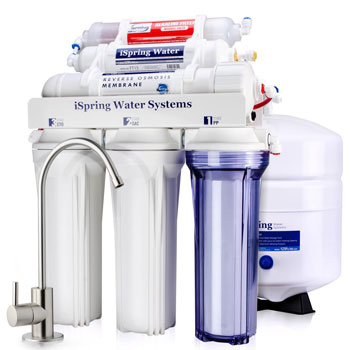 | iSpring RCC7AK Under Sink Reverse Osmosis System |
| View On Amazon |
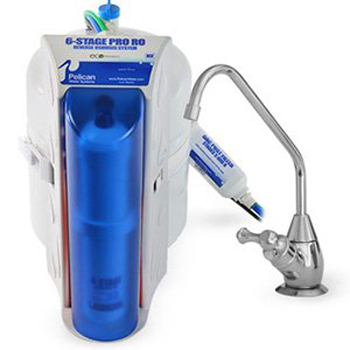 | Pelican Reverse Osmosis System |
| |
 | Home Master Artesian – Full Contact Reverse Osmosis Water Filtration System |
| View On Amazon |
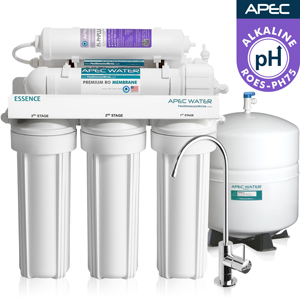 | APEC ROES PH75 6 Stage Reverse Osmosis Water System |
| View On Amazon |
 | Home Master HydroPerfection RO Water Filter System |
| View On Amazon |
 | iSpring RCC7 5 Stage Reverse Osmosis System |
| View On Amazon |
Best Reverse Osmosis Water Filter Reviews (Updated List)
1. Waterdrop Reverse Osmosis System
 The Waterdrop RO system completely changes the game when it comes to domestic water filtration. This unit will save you plenty of space with its compact design as it doesn’t have a tank. The slim body doesn’t mean that the effectiveness is low, though. The Ro membrane comes with a whopping filtration accuracy of 0.0001μm, making sure that your water is free of 99% of all contaminants. The intelligent design also features 2 displays — one for the level of water quality, and one for the TDS number.
The Waterdrop RO system completely changes the game when it comes to domestic water filtration. This unit will save you plenty of space with its compact design as it doesn’t have a tank. The slim body doesn’t mean that the effectiveness is low, though. The Ro membrane comes with a whopping filtration accuracy of 0.0001μm, making sure that your water is free of 99% of all contaminants. The intelligent design also features 2 displays — one for the level of water quality, and one for the TDS number.
You can connect the product to your fridge, but you will need to get a drain separately. Other than that, the installation is quite straightforward and shouldn’t give you any trouble. Changing one of the 3 filters happens in seconds as you only twist it and take it out.
While the system gets rid of fluoride, it will not alkalinize your water and will not improve the pH levels. Bear in mind that you shouldn’t place it sideways as it will not function properly and will likely leak. Also, the system has to be flushed for 30 minutes after installation.
To learn more about the Waterdrop Reverse Osmosis System, click here.
2. Quality Water Treatment SoftPro GREEN RO System
 This RO system comes from a trusted manufacturer that has been in business for over 12 years. This has allowed Quality Water Treatment to develop a reverse osmosis product that comes with either a standard post carbon filter or an alkalizing filter. The difference is that with the second option, you will have improved pH levels in your water.
This RO system comes from a trusted manufacturer that has been in business for over 12 years. This has allowed Quality Water Treatment to develop a reverse osmosis product that comes with either a standard post carbon filter or an alkalizing filter. The difference is that with the second option, you will have improved pH levels in your water.
What we loved about the unit is the excellent value you get because, on top of the effectiveness, you also get a unit made in the US, and it comes with free shipping. The efficiency here is undeniable as this product will waste only about a gallon or two of water, while most RO systems have a waste rating of about 3-4 gallons. The ratio here is 1:1, meaning that every gallon of purified water wastes just a gallon of water.
The filtration happens in 5 stages. You have a 5-micron sediment filter, a 10-micron carbon block (standard for filtration systems), another 10-micron carbon block to completely eliminate chlorine, the RO membrane, and an odor filter to improve the taste dramatically.
All of this will remove up to 96% of the contaminants in your water. You can conduct a DIY installation, and the warranty that you get is five years.
Read Full Review » Quality Water Treatment SoftPro
3. iSpring RCC7AK Under Sink Reverse Osmosis System
 The iSpring RCC7AK has six stages of filtration to ensure that the water you drink, use for cooking, or your coffee is the best it can be. What’s interesting is that the first five stages of filtration remove the contaminants from the water, and the sixth stage is when this system restores all of the beneficial minerals.
The iSpring RCC7AK has six stages of filtration to ensure that the water you drink, use for cooking, or your coffee is the best it can be. What’s interesting is that the first five stages of filtration remove the contaminants from the water, and the sixth stage is when this system restores all of the beneficial minerals.
It’s impressive that the unit can remove up to 99% of contaminants and bacteria lurking in your water. This is maybe the biggest advantage this model offers. Removing some of the fluoride from the water is also an important feature of the product.
The product is fairly easy to install under your sink. You’ll need one or two basic tools. It comes with instructions in the box and has a number to call if you’re struggling with the installation. What surprised us was that it filtered the water in about two minutes, which is a perfect speed for filtration. This makes this unit ideal for large families or families with big drinkers.
After installing and flushing the system at least once, it will be ready to use and give you and your household soft and healthy water.
Read Full Review » iSpring RCC7AK
4. Pelican Reverse Osmosis System
 The effectiveness of this reverse osmosis water filtration system is indeed impressive. The 6-stage Pelican RO system will get rid of a wide array of water contaminants and we are talking about more than 99% effectiveness. Some of the contaminants that come to mind are Arsenic (99%), Chromium 3 and 6 (99% and 98.3%), Turbidity (98.7).
The effectiveness of this reverse osmosis water filtration system is indeed impressive. The 6-stage Pelican RO system will get rid of a wide array of water contaminants and we are talking about more than 99% effectiveness. Some of the contaminants that come to mind are Arsenic (99%), Chromium 3 and 6 (99% and 98.3%), Turbidity (98.7).
Needless to say, chloramine and fluoride will also not be present in your drinking water. The six stages include:
- A sediment filter
- A Pre-filter
- A filter
- The RO membrane
- Polishing stage
- The minerals stage
All of that ensures not only that you get clean water but also one full of minerals and free of odors and smells.
Now the production rate of about 18 gallons per day doesn’t sound like a lot but it should be sufficient for any kitchen. You should not expect to be able to shower using the water from the RO system. You get a maximum pressure of 80 PSI but it also depends on the pressure of your local water supply.
When it comes to filter life, change the 2-stage post-filter every 6 months and the membrane should be swapped every 18 months.
5. Home Master Artesian – Full Contact Reverse Osmosis Water Filtration System
 This may be the most customizable and upgradeable RO system that you will ever find. Because of all these possible additions, you got the opportunity to have one darn effective product. The patented full contact technology presence boosts the final goal (having cleansed water). Thanks to it, the water is remineralized twice, will taste even better, the storage tank will last longer, and the pH levels will be improved.
This may be the most customizable and upgradeable RO system that you will ever find. Because of all these possible additions, you got the opportunity to have one darn effective product. The patented full contact technology presence boosts the final goal (having cleansed water). Thanks to it, the water is remineralized twice, will taste even better, the storage tank will last longer, and the pH levels will be improved.
You will be happy to find out that the manufacturer will also offer you the second faucet. As you know, RO systems require their own tap, and you can get the whole package altogether. In fact, the selection of faucets is impressive as you get to choose between 10+ types.
The product will eliminate 98% of chemicals, sediments, heavy metals, and other contaminants. It will also add useful minerals and will improve the taste dramatically. You will not have to change the filters often as the expected life of a filter is 2,500 gallons. We recommend you change the filter once a year. Replacing a filter is simple because you get rid of the whole housing—no need to detach any water lines.
The system comes with a 30-day money back guarantee and a 5-year warranty.
Read Full Review » Home Master Artesian
6. APEC ROES PH75 6 Stage Reverse Osmosis Water System
 The APEC Top Tier 6 Step is one of the most advanced water filtering solutions you can buy at a decent price. With a 3:1 wastewater pure water ratio, this is an efficient way of filtering your drinking and cooking water.
The APEC Top Tier 6 Step is one of the most advanced water filtering solutions you can buy at a decent price. With a 3:1 wastewater pure water ratio, this is an efficient way of filtering your drinking and cooking water.
This model uses a 6-step filtration process. While most of the water purifying sequence is similar for every reverse osmosis unit, this one has an additional filter which will add minerals to your drinking water. The added minerals will make the water healthier and better tasting at the same time.
One of the advantages of using this model is the longevity of the water filters. While the first three filters have to be changed every six months, the reverse osmosis membrane and the carbon filter have to be changed only once every 2-3 years, depending on your water source. The water neutralizer filter has to be changed once every 4-6 years.
Another advantage is the ease of installation. This RO system comes with a detailed instruction manual, and you will be able to follow it without any problems for a step-by-step guide. If you like following video tutorials more than you like following written instructions, that is also a possibility. There are a lot of helpful videos on YouTube you can watch.
To learn more about the APEC Top Tier 6 Step, click here.
7. Home Master HydroPerfection RO Water Filter System
 The HydroPerfection is perhaps the most accomplished RO system that you can get from Perfect Water Technologies. What we like the most about this unit is the Fast Flow technology, which will double the average flow rate. The efficiency is also there because the purified to wasted water ratio is 1:1. This means that for a gallon of filtered water, only 1 gallon of water goes to waste.
The HydroPerfection is perhaps the most accomplished RO system that you can get from Perfect Water Technologies. What we like the most about this unit is the Fast Flow technology, which will double the average flow rate. The efficiency is also there because the purified to wasted water ratio is 1:1. This means that for a gallon of filtered water, only 1 gallon of water goes to waste.
When it comes to how thorough the system is, users are definitely not disappointed. The HydroPerfection will eliminate 99.9% of all microorganisms, about 98% of all TDS, chemicals, and metals. You will have odorless water with improved taste, excellent for drinking, and cooking.
Changing the filters is easy as you remove the whole cartridge without having to detach anything. The best part is that the filter will survive for about 2,000 gallons meaning that you will need to replace it pretty much only once per year.
The manufacturer allows you to upgrade the faucet that comes with the system, and you also get a 5-year warranty.
Read Full Review » Home Master HydroPerfection
8. iSpring RCC7 5 Stage Reverse Osmosis System
 Another budget choice, the iSpring RCC7 is a high-quality reverse osmosis system, and it filters the water through 5 different filters. Even though this is one of the cheaper models we included in our list, the quality of the water it produces is still top-notch, so the system proves to have a good value.
Another budget choice, the iSpring RCC7 is a high-quality reverse osmosis system, and it filters the water through 5 different filters. Even though this is one of the cheaper models we included in our list, the quality of the water it produces is still top-notch, so the system proves to have a good value.
One of the advantages of using this system is its efficiency. Most reverse osmosis water filtering systems are considered efficient if they have a wastewater pure water ratio smaller or equal to 4:1. With an efficiency ratio of 2.5:1, this model is actually highly efficient.
The instructions manual is clear and detailed if you choose this unit. It’s not poor or difficult to follow. There are video tutorials online that can guide you through the installation. If at any given time you’re stuck and you don’t know what to do next, you can also contact their customer support for advice. iSpring’s customer support experts really know what they’re talking about and they will provide helpful advice and instructions.
To find out more about the iSpring RCC7 – 5 stage, click here.
9. Express Water ROALK10DCG 10 Stage Reverse Osmosis System
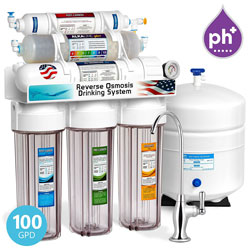 The Express Water ROALK10DCG surely has one of the boldest marketing claims. The manufacturer advertises this model using a 10-step filtration process. While this information is not necessarily untrue, it’s surely deceptive. While most manufacturers consider the remineralization filter as a sixth step, Express Water considers that each step of the mineralization is a separate step of the whole filtration process. So, instead of having a 6-step filtration, this model is advertised as having a 10-step one.
The Express Water ROALK10DCG surely has one of the boldest marketing claims. The manufacturer advertises this model using a 10-step filtration process. While this information is not necessarily untrue, it’s surely deceptive. While most manufacturers consider the remineralization filter as a sixth step, Express Water considers that each step of the mineralization is a separate step of the whole filtration process. So, instead of having a 6-step filtration, this model is advertised as having a 10-step one.
With a wastewater pure water efficiency of 2:1, this is one of the most efficient reverse osmosis systems you’ll find on the market in 2019. Not only is the Express Water ROALK10DCG efficient, but it also has a nice filter system. These filters will remove up to 99% of the contaminants in your water source, and they will also remineralize the water, improving its taste and making it healthier.
Installing this system is easy, and most people will be able to do it themselves in under two hours. The most difficult part of the installation is to find the right place for every filter since there are a lot of them. However, finding the right spot is easy because the filters are color-coded, so you will be able to install them in no time whatsoever.
Click here if you want to learn more about the Express Water ROALK10DCG.
10. Brondell H2O+ Circle Reverse Osmosis Water Filter
 The Brondell H2O+ Circle is a small and compact reverse osmosis system that’s easy to install and very efficient. This model has an efficiency ratio of 2:1 and it’s capable of producing up to 50 gallons of pure water per day.
The Brondell H2O+ Circle is a small and compact reverse osmosis system that’s easy to install and very efficient. This model has an efficiency ratio of 2:1 and it’s capable of producing up to 50 gallons of pure water per day.
One of the advantages of using this filtering system is that it’s very compact. Not only does this make it look better, but it will save up a lot of space, and make filter changes easier as well.
Another advantage is that this reverse osmosis system comes with a stylish faucet. The faucet has a chrome finish, and a built-in LED light will notify you when the filters need changing. If you don’t like the faucet’s chrome finish, don’t worry. You can connect the filtering system to other faucets, as well. Just make sure you contact the customer support to check if your faucet model is compatible with it before you make a purchase.
Although this is a good and efficient reverse osmosis system, one of the disadvantages of using it is that the filters are harder to find than those produced by the competition. You can only find the filters on the manufacturer’s official website, and shipping taxes may apply, depending on where you live.
To find out more about the Brondell H2O+ Circle reverse osmosis system, click here.
11. APEC ROES 50 5 Stage Reverse Osmosis Water System
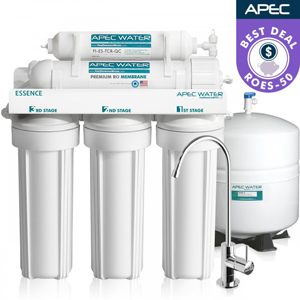 The APEC Top Tier 5 Step is one of the budget choices we included on our list. This reverse osmosis system uses a basic 5-step water filtration process. This model has a water filtration efficiency of 3:1, so it’s above average compared with other models. Despite its lower price, this is a good filtration system, and it will remove most contaminants in your water source.
The APEC Top Tier 5 Step is one of the budget choices we included on our list. This reverse osmosis system uses a basic 5-step water filtration process. This model has a water filtration efficiency of 3:1, so it’s above average compared with other models. Despite its lower price, this is a good filtration system, and it will remove most contaminants in your water source.
One of the advantages of buying this unit is its accessible price. Not only does the APEC Top Tier 5 Step have a decent buying price, but all the filters are also rather cheap. As you would expect, the reverse osmosis membrane is more expensive, but that’s normal since it is the most important component in the filtering system.
Another advantage is the clean and detailed instructions manual. Nobody will have any problems following the instructions during the installation. The images are clear, the indications have short and concise, and every detail is specified, so you won’t miss anything.
This model also comes with a spare set of filters, so once you buy it you’ll be able to use it for at least a year without having to spend additional money.
To learn more about the APEC Top Tier 5 Stage, click here.
12. Countertop Portable 5-Stage Reverse Osmosis Water Filters
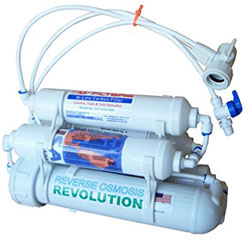 This is the single portable reverse osmosis water filtering system we included on our list. The Countertop Portable Universal 5-Stage is small enough to fit on your kitchen countertop, but you can also hand it from a kitchen cabinet so it won’t take up any space.
This is the single portable reverse osmosis water filtering system we included on our list. The Countertop Portable Universal 5-Stage is small enough to fit on your kitchen countertop, but you can also hand it from a kitchen cabinet so it won’t take up any space.
The major advantage of using the Countertop Portable Universal is its portability. Not only does this mean you can take it with you when you leave on vacation, but it also means you won’t have to waste time installing it. The installation process will literally take up to two minutes, and you won’t need any tools for it. You might need an adjustable wrench, but only if your faucet’s aerator is too tightly screwed to be removed by hand. The system is compatible with over 90% of the most popular faucets currently available on the market, so you shouldn’t have any problems with its installation.
Another advantage of this RO system is its efficiency. The Countertop Portable Universal will produce 2.6 gallons of wastewater of every gallon of pure water it produces. This means that this model is very efficient, despite its small size.
A slight disadvantage is that this model doesn’t come with a tank. This means you will have to manually turn the unit on and off when you want, and use a water recipient of your own to collect the water. This is not a major con, but you won’t have any filtered water if you forget to fill a recipient.
To learn more about the Countertop Portable Universal 5-Stage, click here.
13. Express Water RO5DX 5 Stage Reverse Osmosis Filter
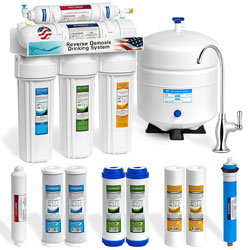 The Express Water RO5DX is a good reverse osmosis water filtering system that can be bought for an acceptable amount. Even though this is a cheap RO system, it’s still very good and efficient, and it fully deserves its place on this list.
The Express Water RO5DX is a good reverse osmosis water filtering system that can be bought for an acceptable amount. Even though this is a cheap RO system, it’s still very good and efficient, and it fully deserves its place on this list.
With a wastewater pure water ratio of 3:1, this is an efficient unit that will produce pure water and save you money in the long run. Using an efficient filter is also better for the environment, as less water is wasted.
One of the advantages of using this unit is high-quality filters. Even though this model only uses a 5-step filtration process, the filters are capable of removing up to 99.99% of the contaminants in your water source. The filters are also easy to change, and you won’t need other tools than the filter wrench provided by the manufacturer for this operation.
Another advantage is that this RO system is easy to install, and you can do it quickly. The filters are pre-assembled, so that will save you some time. The instructions manual is easy to follow, and all the instructions are detailed and concise.
If you want to find out more about the Express Water RO5DX, click here.
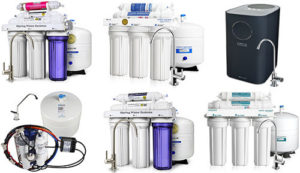
Reverse Osmosis System Buying Guide
If you decide to equip your home with a reverse osmosis filtering system, you can rest assured that the water you drink will be free of contaminants. However, the market is flooded with a plethora of products to view. Your decision could be less stressful if you know what you want and need.
Traits in the Personality of a Reverse Osmosis System – Features and Specifications
If you are here, then you have probably decided that a reverse osmosis system is an extremely beneficial device for your health and home. Since the conditions in your house are the right ones for it, then it is time for the RO system to tell you what it can offer. We will list some of the essential features and specifications of reverse osmosis devices that you will encounter:
Semi-Permeable Membrane
This piece is probably a vital element for every reverse osmosis system. As the name indicates, the membrane stops some particles before the water reaches your tap. Thus, you receive water filtrated from the contaminants.
Filters
The RO system filters the water at various stages to provide the optimal quality of usable water. The filters have the task to remove dissolved salts, dissolved organic substances, and micro, fine particles of water. A standard system includes the following filters:
- Sand Filter
- Carbon Filter
- Cartridge Filter
- Membrane Filter (Listed above)
High-Pressure Pump
This feature is optional. As we mentioned in the previous section, your water pressure could benefit from a reverse osmosis system, which has this component. The pressure pump will not only increase the flow, but it will also assist your RO system in performing adequately over a long time.
Compact
Although a reverse osmosis system may take up space under your sink, it comes as a compact unit considering the weight of the mission it has. A standard RO system contains a three-dimensional configuration of modules to minimize the space it needs. As a compact filter, you may also want to consider a top-notch under sink water filter.
Simple Operation
A great advantage of RO systems is that they do not require your assistance to function because they are fully automatic. After you install them, they will perform the process with ease. Don’t forget that they also need to undergo regular maintenance, however.
Voltage
Standard 120V 3-prong plugs are compatible with RO systems.
Alkaline Re-Mineralizer
Another optional feature that we mentioned. It makes sure that the healthy minerals remain in the water that the line supplies you with. That way, you will stop worrying if reverse osmosis water is good for you.
Storage Tank
It holds about 3 gallons of water. Without enough water in the tank, the RO system would not be able to function.
Cold Water Valve
Takes the water supplied from a well or a treated municipal source.
Shut-off Valve
Prevents the waste of water when the storage tank is full. It stops the water from going into the tank when it detects that the limit has been reached.
What Is a Reverse Osmosis Filtering System?
There are several things you should be aware of when you’re looking to buy a reverse osmosis water filtering system among many other water treatment technologies for household use. Most household owners heard of this kind of system, but they don’t really know what it is and how it works. In the following section, we will explain the most common terms you’ll encounter when looking for a reverse osmosis water filtering system, and how this type of system works.
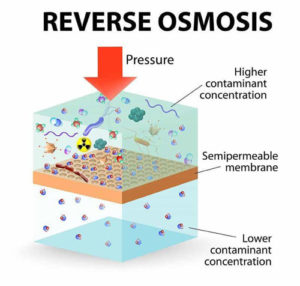 Reverse Osmosis, most commonly known as an RO system, is a water purification technology that passes the water through a semipermeable membrane to remove the polluting particles. For further information, check our blog post comparing and contrasting distilled and purified water.
Reverse Osmosis, most commonly known as an RO system, is a water purification technology that passes the water through a semipermeable membrane to remove the polluting particles. For further information, check our blog post comparing and contrasting distilled and purified water.
Unlike other water filtering systems, RO is able to remove smaller particles, either dissolved or suspended floating in the water, so the filtered water’s quality will be better. RO systems are able to remove particles as small as ions, molecules, and even some species of bacteria from the water, and they are used in the industrial production of potable water.
Reverse osmosis is also one of the processes that are able to remove salt from saltwater, for recycling, wastewater treatment, and it can even be used to produce energy.
Basics of Reverse Osmosis
To understand how a reverse osmosis filtering system works, you first have to understand the main principles of osmosis. Osmosis is a naturally occurring process where a weaker saline solution tends to migrate towards a stronger one. If for example, you have two containers connected through a pipe but separated by a semi-permeable membrane, one containing a saline solution, the other freshwater, the freshwater will tend to flow towards the saline container. This happens because solutions have a natural tendency to seeking a higher concentration.
Reverse osmosis follows the same process, only in reverse. Instead of having a solution with a lower concentration shifting towards a more concentrated one, an external force is applied to the concentrated solution, making it move towards the lesser concentrated one. The semi-permeable membrane will only allow molecules of a certain size to pass through it, so the majority of salts, microorganisms, bacteria, and other debris will be blocked.
What to Consider When Buying a Reverse Osmosis System
Here are some things you should know before you purchase a system:
Storage
The reverse osmosis system should go in the cabinet under the sink. Note that such a device requires quite a bit of space, which means you may need to dispose of your bin. Besides the prefilters and the reverse osmosis components, there should be enough space for the tank. A limited space would not be suitable for a reverse osmosis system.
Water Pressure
These devices do not function properly if the pressure is below 40PSI. There is a chance that you might be able to increase the pressure of your waterline with a booster pump. Some reverse osmosis systems come in pumped (with a booster pump), and others come without a pump. Note that if the water pressure cannot go up even with a pump, then a reverse osmosis system will not be suitable for your house.
Water Usage
One of the primary concerns with reverse osmosis systems is that they consume vast amounts of water. The water that carries the contaminants to the drain is more than the water that is filtered to become suitable for usage. This factor is significant because some people might not have the option of wastewater.
Source
If you live in an urban area, a treated city source is probably providing you with water in your house. The water in further suburban regions might be coming from a well. Check the descriptions of reverse osmosis systems because some might be more suitable for filtering the contaminants from well water more than others.
Remineralization
There is a tendency in reverse osmosis systems to be so diligent in filtering water that they also remove some of the healthy elements from the water. Therefore, you might consider purchasing a unit that has an alkaline re-mineralizer filter that re-introduces the beneficial minerals back to your water.
Replacement Filters
For any water filtering unit to perform the way it did when you purchased it, you will need to do regular maintenance work. Some people find the task to maintain an RO system to shape a tiring job because of the multi-staged filtering process. The reverse osmosis system has more than one filter. You need to keep track of every replacement you make because some filters require more frequent changes than others. This detail also adds more to the cost of a single system.
These factors are crucial because, to speak the truth, sometimes a different water filtering device might be more compatible with the conditions in your area and house. However, if you cover all the requirements, an RO system will improve the quality of the water for you.
How Do Reverse Osmosis Filters Work?
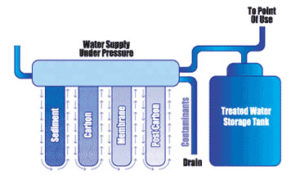 Reverse osmosis drinking water systems work by applying external pressure on the water, forcing it to pass through the semipermeable reverse osmosis membrane. When the water passes through this membrane, 95 – 99% of its components are blocked and diverted into the reject stream. The amount of pressure needed for this operation depends on the quality of the water source. If a water source is more contaminated, the pressure required to push it through the RO membrane will be higher.
Reverse osmosis drinking water systems work by applying external pressure on the water, forcing it to pass through the semipermeable reverse osmosis membrane. When the water passes through this membrane, 95 – 99% of its components are blocked and diverted into the reject stream. The amount of pressure needed for this operation depends on the quality of the water source. If a water source is more contaminated, the pressure required to push it through the RO membrane will be higher.
The resulting filtered water is desalinated by RO and demineralized. It is technically called permeate ( or product) water. You’ll more often find it called filtered or pure water in instructions manuals and product descriptions. The water stream carrying the contaminants is technically called the reject (or concentrate) water. You will more often find it called wastewater. This stream doesn’t pass through the semipermeable membrane.
When the water stream enters the RO membrane, the water molecules are allowed to pass, but the dissolved salts and other contaminants are blocked. Instead of accumulating near the membrane, these contaminants are discharged using another stream of water. This wastewater stream and its destination differ depending on the RO system used. Most of the time, the wastewater is directed straight to the drain, but other times it can be sent back to the main water supply, or it can even be recycled through the system in order to save water. Most RO systems can divert this water so you can use it to water your plants or wash your pavement.
The filtered water has superior quality, and it usually contains only 1 – 5% of the contaminants it did before the filtration.
Reverse osmosis filters use the cross filtration process instead of standard filtration. In a standard filtration, the contaminants are collected and absorbed by the filters. This makes the filters less efficient over time, as the level of contaminants contained grows. With cross filtration, however, the filtered water goes one way, while the contaminated one goes another. Water is used to sweep away the contaminants, and the same water keeps the reverse osmosis’s membrane surface clean.
Reverse Osmosis Step by Step Process
Reverse osmosis systems usually have 5 filtration steps or more, some of them claiming to have as many as 10 individual steps. No matter how many steps an RO system has, the first 5 are usually the same. They will often have different names but do the same thing. Here is a brief description of the main filtration steps.
- Step – This is the sediment removal stage. Usually, the first filter is used to block larger contaminants, like clay, rust, stones, and silt from the water. Most manufacturers use a 5-micron filter for this step. Any particle larger than this will be suspended, ensuring no harmful elements will reach the membrane.
- Step – This is usually the first carbon filter step. This filter is used to remove most of the harmful chemicals in the water, including chlorine. These chemicals can be harmful and they can change the water’s taste, so they have to be removed.
- Step – The second carbon filter. This is where most of the remaining particles in the water are suspended. Unlike the first carbon filter, this one is denser and more compact. This allows it to block more particles from the water, the resulting stream being almost clean.
- Step – This is the most important step in the filtration process. This is where the water has to pass through the reverse osmosis membrane. The RO membrane is a semi-permeable membrane capable of removing even the smallest particles. Usually, the contaminants are removed according to their weight, size, and ionic charge. Elements larger than 0.0001 microns are removed from the water, and so are those with a molecular weight above 200, or a high ionic charge. This is where all the heavy metals present in the water source are removed, and also the radioactive components. At this point, all the suspended contaminants are drained out of the RO system, and the pure water is separated.
- Step – This can be the last step for many reverse osmosis systems, but others can follow as well. This is a very important step in the filtration process, even if it’s the last one. During this step, chlorine, bacteria, viruses, and bad smells or odors are removed from the water. If this is the last filtration step, the filtered pure water goes directly to your faucet or in the water tank, depending on the system.
- Step – This is an additional step in the filtration process, and it has a major role in producing better-tasting water. After the water passes through the reverse osmosis membrane, most of its contaminants are removed. Unfortunately, so are the minerals in the water. Most people rely on their drinking water as a source of minerals, and drinking a lot of mineral-free water can be more harmful than good for your body. In this step, however, minerals are added to the filtered water. This will make the water healthier, but it will also make it better tasting, as the added minerals will increase the water’s pH. The resulting water will have a similar taste to that of bottled water.
- Step – This is an additional step used by only some of the manufacturers. Even though this step is rarer, it is also very good. This is the UV filter, and it has a major role in reducing the number of bacteria, viruses, and microorganisms in your water. The UV filter is usually a UV light bulb, so the RO systems that use one will also need a power source, like an electrical outlet. The UV light will kill most of the animated contaminants present in the filtered water, making it healthier and better suited for human use, especially for children or the elderly.
- Any Steps Above The Seventh – Some manufacturers have divided the remineralization process into more steps, thus increasing the overall filtering steps of their RO systems. While their products may be advertised as 10-step systems, the added steps are only part of the mineralization process and do nothing more.
Contaminants Removed by Reverse Osmosis Filter
Reverse osmosis filters are actually some of the most advanced water filtering systems you can buy for your home. An RO system is capable of removing up to 99.99% of the contaminants in your water, depending on the quality of your water source.
The RO membrane blocks the contaminants based on their size and ionic charge. Usually, a contaminant with a molecular weight higher than 200 is blocked. Similarly, any particles larger than 0.0001 microns will also be blocked. At the same time, particles with a higher ionic charge will also be stopped by the RO membrane. For example, calcium has two ionic charges and it’s easier blocked than sodium, which only has one ionic charge. For this same reason, CO2 particles are usually not blocked as they go through the RO membrane. CO2 particles are not highly charged, and they are relatively small in size, so the RO membrane has a tougher time removing them.
Due to their high water filtering efficiency, reverse osmosis filters are very efficient at treating ground or surface water. You can even use them to treat brackish water. Reverse osmosis filters are used in the food and beverage industries, in the pharmaceutical industry, and by the semiconductor manufacturing industry.
What Does TDS Mean?
TDS means total dissolved solids. When it comes to drinking water, TDS usually means all the inorganic components in the water, such as calcium, sodium, potassium, chlorides, sulfates, and bicarbonates, along with some of the organic matter dissolved in the water.
TDS can be measured in a lab, or by measuring its electrical conductivity. Measuring the TDS level in a lab is more accurate and reliable than measuring its conductivity, but it’s also more expensive. Measuring the electrical conductivity is inexpensive, and the results are within 10% of the ones you get in a lab.
A high-quality RO water filtering system is capable of reducing up to 90% of the TDS in your water, but this amount varies depending on your water source.
RO Water Efficiency Ratio Explained
If you’re looking for a reverse osmosis water filtering system, you most likely already noticed that all the models come with an efficiency ratio. Reverse osmosis systems are considered efficient if their wastewater pure water ratio is smaller or equal to 4:1, but how is this ratio calculated?
One of the problems with this efficiency ratio is that the standard calculating procedure is not very realistic. Every reverse osmosis system is tested at ideal conditions when the water’s temperature is at 77 degrees F, and the water pressure is 60 PSI. Unfortunately, these conditions are rarely encountered in real life, so your system’s efficiency will vary.
This will most often mean that the RO system you buy won’t perform as well as you would expect. It will frequently have considerably less output than the one presented on the sheet. It’s complicated to calculate the exact output of the system. Low water temperatures and low water pressure considerably reduce the output. On the other hand, so does a high TDS level. If your water source has a high TDS level, the amount of water necessary to displace the contaminants will be higher.
Permeate Pump. Do You Really Need It?
Most people believe that the permeate pump is equivalent to the electric pump, but it’s not. The permeate pump enhances the reverse osmosis system’s performance without producing any additional pressure for the unit. Instead, the permeate pump reduces the back pressure produced by the system’s water storage tank. This allows the RO unit to use all the pressure it has.
The permeate pump works by storing the wastewater’s hydropower and using this energy to power the pure water under pressure into the system’s water tank. RO water tanks use air pressure to push the filtered water out of the faucet. RO systems without a permeate pump use some of their pressure to force the water into the tank, so their efficiency will decrease. Units with permeate pumps will use the pressure created by the wastewater to push the pure water into the tank. The result is a remarkable increase in power and efficiency.
Another advantage of using an RO system with a permeate pump is that it will also be more economical and environmentally friendly. Since the system can fill the water tank without so much back pressure, less water is rejected and the filtered water is purer.
Remineralization Filters. Do They Really Help?
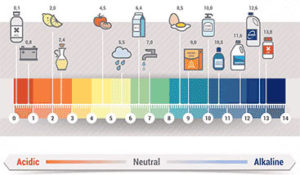
One of the first things you’ll notice when you talk about RO systems is that people say the filtered water has an unusual taste. The change in taste is due to the water being filtered through the RO membrane. When water pushes through the membrane, it will lose most of its components, and its pH value will be lowered. This will make the water more acidic, changing its taste.
If you tasted the filtered water and you believe it has an unusual taste, you should look for an RO system with a remineralization filter. This filter will add minerals to the water, increasing its pH. The resulting filtered water will taste like bottled mineral water.
What Is an Air Gap Faucet? Is It Any Good?
If you’re looking for a reverse osmosis water filter, chances are, you noticed some of them come with an air gap faucet, while most of the models that don’t have it as a standard offer it as an option.
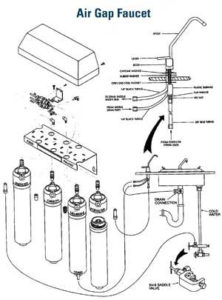 Air gap faucets provide a siphon break for reverse osmosis systems installed under the sink. This means that in the eventuality of a block in your sink, the dirty water won’t be siphoned into your RO system. Depending on where you live, the local legislation might require that all the RO systems have an air gap faucet.
Air gap faucets provide a siphon break for reverse osmosis systems installed under the sink. This means that in the eventuality of a block in your sink, the dirty water won’t be siphoned into your RO system. Depending on where you live, the local legislation might require that all the RO systems have an air gap faucet.
The main disadvantage of having an air gap faucet is the difficult installation. They usually need a different sized hole for the installation, and they also need three pipe connections instead of one. Some customers also claim that the air gap faucets are really noisy, thus lowering the overall rating of the RO system.
What Is The Difference Between a Single Pass and a Double Pass RO System?
A single-pass reverse osmosis system follows the filtration process once. The double pass RO systems use the pure water produced by the first pass as the first one uses the water feed. This way, the water is filtered twice before reaching your faucet. The water filtered by a double pass RO system has a higher quality than the one produced by the single-pass system because it is actually filtered twice.
Another difference between the two types of water filters is that the second pass system removes more carbon dioxide particles by injecting a caustic between the passes. The caustic increases the water’s pH and transforms the carbon dioxide into carbonate and bicarbonate, making it easier to block. Adding a caustic before the first pass is impossible because it would make the calcium particles attach to the RO membrane.
What’s The Difference Between a One-Stage and a Two-stage System?
When you use a one-stage reverse osmosis system, the water that enters the system goes out as partially pure water and partially wastewater.
In a two-stage system, the pure water from the first filter is collected, and the wastewater becomes the feed water for the second pass. The resulting pure water is then combined with the first one collected, and that’s the water collected in the water tank.
Reverse Osmosis Systems Installation & Maintenance
How to Install a Reverse Osmosis Water Filter
 Most of the RO systems we reviewed are easily installed. In fact, one of them doesn’t need any installation. It just needs to connect to your faucet and it’s ready to work. The Countertop Portable Universal 5-Stage is a portable unit. You can connect and disconnect it to the faucet by simply twisting the aerator off and twisting the RO system on. Visit our web site for more countertop water filter models.
Most of the RO systems we reviewed are easily installed. In fact, one of them doesn’t need any installation. It just needs to connect to your faucet and it’s ready to work. The Countertop Portable Universal 5-Stage is a portable unit. You can connect and disconnect it to the faucet by simply twisting the aerator off and twisting the RO system on. Visit our web site for more countertop water filter models.The rest of the filter systems we reviewed have to be installed permanently. Even though they’re made by different manufacturers, the installation process is pretty much the same all around.
Most people will be able to install the RO systems on their own, without relying on professional help. However, keep in mind that these systems are designed to be installed in a kitchen cabinet under the sink. If you plan on installing them farther away from the sink, in a basement, or a storage area, you should buy all the necessary additional parts beforehand. For most people, the toughest part of the standard installation is drilling a new mounting hole for the pure water faucet.
Keep in mind that you have to check with your local authorities before installing a faucet. Some might demand you install an air gap faucet instead of a standard one. You should also note that some kitchen sinks come with an additional faucet hole that might be blanked off. If this is the case, you don’t need to drill a new hole for the faucet, you only have to remove the existing cover.
RO System Installation In 9 Steps
All the RO systems we reviewed have a simple installation process, and most people will be able to handle it on their own thanks to the color-coded connectors that are also push to fit. This will provide a good connection without having to rely on special tools. Here are the steps you should follow for a good and swift installation:
- Disconnect The Cold Water – Remove the cold water feed pipe the whole length from the wall to the faucet
- Install The T-connector – All the RO systems come with a T connector and a push-fit connector. In some cases, the push-fit connector might already be attached.
- Connect The Waste Pipe – You have to drill a hole in the waste pipe if you want to install the waste connector. The best place to make the hole is in the horizontal section of the waste pipe, as it will reduce the noise produced by the water flushed down when the system is working.
- Mount The Filter – For most of the models we reviewed, you will have to mount the filter to the side of the cupboard. Keep in mind that you will have to periodically change the filters. So, you should mount the filters in such a way that you will have plenty of free space for this operation.
- Install The Water Tank – Install the water tank on the cupboard’s base. Make sure you install it on a flat and level surface.
- Connect The Water Pipes – While this process might seem complicated, it’s actually very simple thanks to the color-coded connectors. This is a great way to make sure all the connections are in the right place.
- Plug The System In An Electrical Outlet – This step will only be necessary for the RO systems that have a UV filter. Make sure the electrical outlet is placed close enough to the RO system, so the power cord will reach it.
- Turn The Water Back On – Turn the water on and look closely for any leaks. If there are some leaks, turn the water off and try to remedy the failure using Teflon tape. However, keep in mind that you shouldn’t use Teflon tape if you install the Countertop Portable Universal because that will surely lead to leaks.
- Fill And Empty The Water Tank – This is an important step in the installation process, as it will activate the filters. Check the instruction manual provided by the manufacturer to find out how many water tanks you have to fill and empty before drinking the filtered water. Do not drink the water before this step is completed.
Reverse Osmosis Systems Filter Change and Maintenance
Once the system is installed and running well, there are not many things you have to do except changing the filters.
Depending on the RO system and your water source, the interval for the changes will be shorter or longer. On average, most systems we reviewed use filters that have to be changed once every 6 months. There are some that have more durable filters, like the Home Master ULTRA-ERP, and you should only change their filters once every year.
As a rule of thumb, the filters before the reverse osmosis membrane, also known as the pre-membrane filters have to be changed once every 6 – 12 months. The RO membrane has to be changed every 2 – 3 years, even though some models use membranes that can last even 4 years without changing. The filters that come after the RO membrane are also more durable. Also, you will have to change them only once a year, or even once every 2 years.
Some models come with transparent filter cases, so you will be able to see when it’s time to change the filters, while others come with LED lights notifications, so you will always know when to change them.
All the systems we reviewed have easy to change filters, even if they are slightly different. In most cases, you won’t need any additional tools for the filter change, while for others you will need the filter wrench provided by the manufacturer. No matter which RO system you choose, changing the filters will only take a few minutes every 6 months or so, the rest of the time being spent without any maintenance necessary.
FAQs
For the last part of our buying guide, we gathered some of the most frequently asked questions from customers around the country. We will make sure that you receive satisfying answers before you go and find the most suitable product for your house.
- What substances do reverse osmosis systems remove?
RO systems have several filters, each responsible for eliminating specific contaminants. Amongst those are lead, copper, magnesium, sand, fluoride. They are all harmful to your health and may lead to issues and malfunctions in your body. Since water is so essential in our lives, the RO system has a crucial task in removing the elements which are not beneficial for us. - Does the RO system pose any risks to your health?
While the RO system removes harmful particles, it also takes away some essential elements that enter our bodies through the water daily. Calcium and magnesium are particularly beneficial for the bones, as well as some other minerals that find a place in the water. Thus, the debate over the advantages and disadvantages of RO systems continues. However, the device itself does not create new risks to your health. - Does the RO system have an impact on the environment?
The most prominent environmental impact of RO systems comes from water waste issues. For every 2 gallons of purified water, 8 gallons go into the water waste system. Not only that this increases the cost of your water bills, but it also seems like a lot of water could come to use. A simple solution is to use the wasted water for other purposes. At the same time, an RO system prevents a lot of people from purchasing tons of bottled water every year. - How long will a reverse osmosis system last?
As long as you perform regular and diligent maintenance, the unit should last you virtually forever. Remember to replace each of the filters as required to enjoy the better taste of the water. - Is a reverse osmosis system like a distiller?
They are different devices, with differing working processes, but similar ending results. As you already know, the RO system uses a semi-permeable membrane to filter the water. The distiller boils the water and then condenses the steam to purify it. A big deal of the contaminants remain in the unit and are not released with the water you will drink. Water distillers, as well as RO systems, benefit from the useful functions of a carbon filter.
Conclusion
Reverse osmosis water filtering systems offer one of the most advanced ways of producing clean water for your household. Recent technological advancements lead to an increase in efficiency and quality, so new RO systems produce water of similar quality to bottled water.
RO systems are easy to install and to use, and they are capable of removing 95 – 99% of the contaminants floating in your water. Despite their higher initial cost, these are durable units, most of them able to produce high-quality water for 10 – 15 years or more.
We hope you find something that fits your needs in the best reverse osmosis system reviews! Remember to have a look at our water purification tablet reviews, as well!

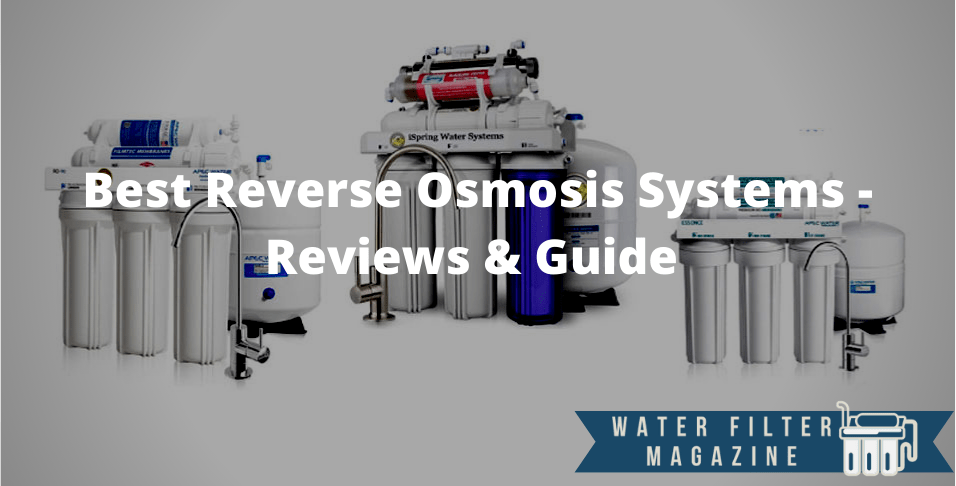
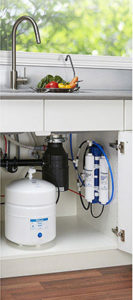 Most of the RO systems we reviewed are easily installed. In fact, one of them doesn’t need any installation. It just needs to connect to your faucet and it’s ready to work. The Countertop Portable Universal 5-Stage is a portable unit. You can connect and disconnect it to the faucet by simply twisting the aerator off and twisting the RO system on. Visit our web site for more
Most of the RO systems we reviewed are easily installed. In fact, one of them doesn’t need any installation. It just needs to connect to your faucet and it’s ready to work. The Countertop Portable Universal 5-Stage is a portable unit. You can connect and disconnect it to the faucet by simply twisting the aerator off and twisting the RO system on. Visit our web site for more